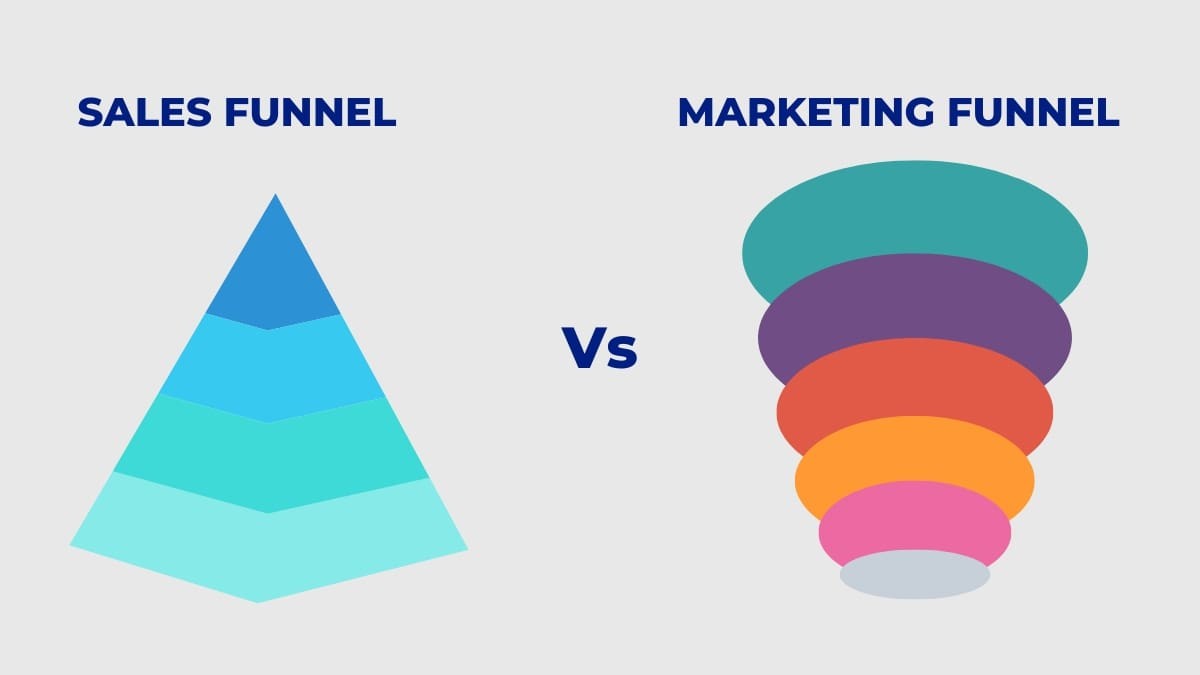Sales Funnels vs. Marketing Funnels: What’s the Difference?
In the realm of marketing and sales, understanding the distinction between sales funnels and marketing funnels is crucial for developing effective strategies. Both types of funnels play a key role in guiding potential customers through their journey, but they focus on different stages and objectives. Here’s a detailed comparison to help clarify their differences and applications.

Sales Funnels
Overview: Sales funnels are designed to guide potential customers through the buying process, from initial awareness to final purchase. The primary goal is to convert prospects into paying customers.
Key Stages:
- Awareness: Prospects become aware of your product or service.
- Interest: They show interest and seek more information.
- Decision: Prospects evaluate options and make a decision.
- Action: The final step where a purchase is made or a transaction occurs.
- Retention (Optional): Some sales funnels also include post-purchase stages to focus on customer retention and loyalty.
Focus:
- Conversion: Aims to convert leads into customers.
- Sales Process: Centers around the sales process and final transaction.
- Sales Team: Often managed by sales teams who handle direct interactions with prospects.
Example: A sales funnel might involve a prospect receiving a targeted sales email (awareness), attending a product demo (interest), receiving a proposal (decision), and making a purchase (action).
Pros:
- Direct Focus: Emphasizes converting prospects into customers.
- Sales-Centric: Streamlines the sales process and identifies high-potential leads.
Cons:
- Limited Scope: May not address broader marketing efforts or brand awareness.
- Narrow Focus: Primarily focuses on the conversion stage, potentially neglecting early stages of the customer journey.
Marketing Funnels
Overview: Marketing funnels encompass the entire customer journey, from awareness to post-purchase engagement. They focus on nurturing and guiding prospects through various stages before and after the purchase.
Key Stages:
- Awareness: Attract potential customers through marketing efforts.
- Interest: Engage prospects with valuable content and information.
- Consideration: Provide detailed insights and address concerns.
- Conversion: Encourage prospects to take action, such as making a purchase.
- Loyalty: Foster customer loyalty and encourage repeat business.
- Advocacy: Turn satisfied customers into brand advocates who refer others.
Focus:
- Holistic Approach: Covers the entire customer journey, including pre-sale and post-sale stages.
- Engagement: Emphasizes building relationships and long-term engagement.
- Marketing Teams: Managed by marketing teams who focus on content, lead nurturing, and brand building.
Example: A marketing funnel might involve a prospect discovering a blog post (awareness), subscribing to a newsletter (interest), participating in a webinar (consideration), making a purchase (conversion), receiving follow-up emails (loyalty), and sharing positive feedback on social media (advocacy).
Pros:
- Comprehensive View: Addresses all stages of the customer journey, not just the sale.
- Engagement and Retention: Focuses on building lasting relationships and customer loyalty.
Cons:
- Complexity: May require more resources and coordination to manage.
- Extended Timeframe: Often involves longer timeframes to see results and conversions.
Key Differences
- Objective:
- Sales Funnel: Focuses primarily on converting leads into customers and finalizing the sale.
- Marketing Funnel: Encompasses the entire journey, from attracting leads to nurturing relationships and fostering loyalty.
- Scope:
- Sales Funnel: Narrow, with a focus on the sales process and conversion stages.
- Marketing Funnel: Broad, covering awareness, consideration, conversion, and post-sale engagement.
- Management:
- Sales Funnel: Typically managed by sales teams with a focus on direct interactions and closing deals.
- Marketing Funnel: Managed by marketing teams with a focus on content creation, lead nurturing, and brand development.
- Stages:
- Sales Funnel: Primarily includes awareness, interest, decision, and action.
- Marketing Funnel: Includes awareness, interest, consideration, conversion, loyalty, and advocacy.

Conclusion
Sales funnels and marketing funnels serve distinct but complementary roles in driving business success. While sales funnels are essential for closing deals and generating revenue, marketing funnels provide a comprehensive approach to engaging prospects and building long-term relationships. Understanding these differences helps businesses create effective strategies that address both immediate sales goals and broader marketing objectives.
For expert advice on optimizing your sales and marketing funnels, contact MyHoardings. Our team can help you design and implement strategies that drive growth and improve customer engagement.
MyHoardings
Phone: +91-9953847639
Email: business@myhoardings.com
Website: www.myhoardings.com
Advertising options at IT Tech Parks in Bengaluru, Hyderabad, Delhi and Mumbai
| Media Type | Advertising Options | Rates (Starting From) |
|---|---|---|
| IT Tech Park Media | Kiosk Setup | INR 25 K / Day |
| IT Tech Park Media | Lift Gate Ads | INR 50K / Lift / Month |
| IT Tech Park Media | Wall Signage | INR 30K / Month |
| IT Tech Park Media | Cycle Docking Stations | INR 90K / Month |
10 Tips for Marketing to Millennials – |




